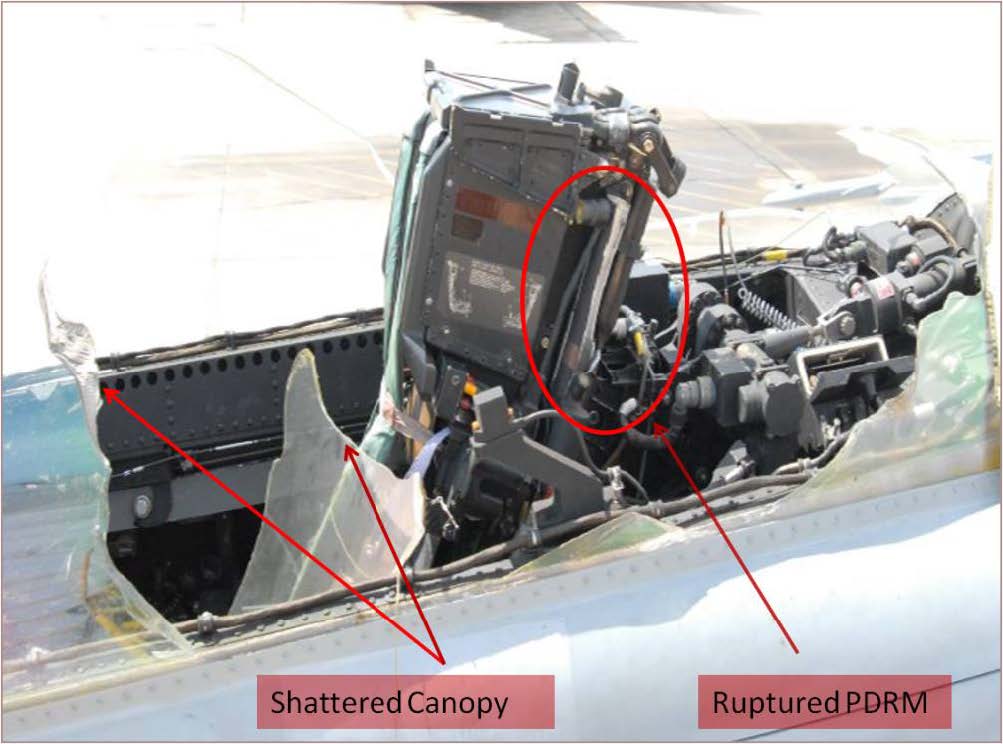
Lone Star Analysis has developed predictive and prescriptive analytics to predict the remaining useful life of avionics and other systems, such as Cartridge Actuated Devices/Propellant Actuated Devices (CAD/PADs), used to power ejection seats. Pictured is a photo taken after an un-commanded CAD/PAD activation in a Navy F/A-18D in 2007. Photo: U.S. Navy
Commercial and government customers of Dallas-based Lone Star Analysis have realized significant avionics cost savings and aircraft availability from the firm’s predictive and prescriptive analytics solutions, its CEO told Avionics International.
The dollar return on analytics can be 20 to 1 or more for customers, according to Lone Star Analysis.
“At the enterprise level, one of the things that’s probably spread across more kinds of fleets of airplanes than anything else we do are staffing prescriptions,” Steve Roemerman, the CEO of Lone Star Analysis, said in a telephone interview on June 4. “If you think about any sort of big fixed asset fleet, that requires skilled people to keep it flying. Typically, whoever is trying to do the staffing planning is doing it one or two years out because skilled mechanics especially are really hard to hire. It’s a really complicated, interesting problem. You don’t know exactly how you’re going to use those assets next year. You don’t know what the weather’s going to be. Maybe you’re going to introduce some younger airplanes, maybe something you haven’t flown before so you don’t know what your experience is going to be, and you’ve got some things that are aging into an era of their life you haven’t experienced before.”
“A lot of what we do is based on the mathematics of uncertainty,” Roemerman said. “We build a big Monte Carlo hedge that runs through all the variables that that fleet operator has uncertainty about.”
Such variables can include avionics components and shops. Several Lone Star Analysis customers have used the company’s analytics to help resolve work demands placed by the Automatic Dependent Surveillance-Broadcast (ADS-B) mandates, Roemerman said. The Federal Aviation Administration (FAA) has required ADS-B Out equipage for flights after January 1 this year in U.S. airspace where a transponder is required.
Lone Star Analysis relies on Monte Carlo simulations and a guided Artificial Intelligence (AI) process in which, instead of initiating a simulation with a neural network or another general AI method, a customer’s known requirements, such as annual inspections or removing avionics cards after 100 flights, are pulled out first to limit the number of variables and uncertainty.
Limiting such uncertainty is crucial for flight safety decisions by fleet operators.
Last year, the U.S. Naval Air System Command’s Precision Strike Weapons Program Office (PMA-201) issued a contract to Lone Star Analysis to develop a digital twin of MT29, WB15, and MT30/31 Cartridge Actuated Devices/ Propellant Actuated Devices (CAD/PADs) used to power the ejection seats in F/A-18 aircraft. PMA-201’s purview includes the sustainment of all cartridge/propellant actuated devices.
The Navy wants to prevent the uncommanded activation of the jets’ parachute deployment rocket motors (PDRM), such as a PDRM auto-ignition in the ejection seat of an aircraft at Naval Air Station (NAS) China Lake, Calif. that occurred in July, 2007. The explosion destroyed the canopy and severely damaged the rear ejection seat. A second PDRM un-commanded PDRM actuation occurred in August, 2017 in the rear seat of an F/A-18F parked at NAS Lemoore, Calif.
The digital twin is intended to predict the remaining useful life of the CAD/PADs due to heat exposure to the stabilizers in the devices based on the historical and scheduled future location of the aircraft they are installed in.
While the Navy had used regular calendar inspections of the CAD/PADs and manuals to determine the remaining useful life the devices, the Lone Star Analysis digital twin has proved more accurate in determining which CAD/PADs need to be replaced and which can extend their service life, Roemerman said.
Lone Star Analysis built and delivered the digital twin in its TruNavigator platform, which allows the user to quickly run as many scenarios as desired to predict the remaining useful life of the specified device.
“Preliminary results show that the current policy of removing and replacing devices after two years of service life does not provide optimal utilization based on the location of the aircraft,” according to a summary of a Lone Star Analysis presentation last year. “Depending on location, stabilizer depletes in as little as 12 months to over 5 years. PMA-201 can now utilize the digital twin to help identify an optimal and safe device replacement and inventory strategy as well as applying the current methodology to scale to other devices.”
Roemerman said that Lone Star Analysis is also supplementing its analytics expertise with Health and Usage Monitoring Systems (HUMS) for helicopters.
“We have a number of initiatives in that area,” he said. “That’s a great example of where there’s an enormous amount of data capture that really nobody knows very much about. That’s really rich, untapped and ready for good analytics.”